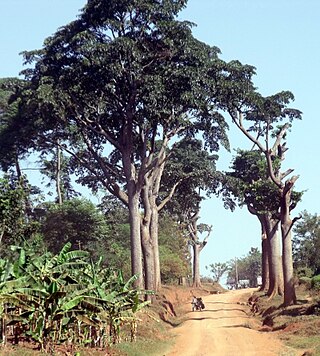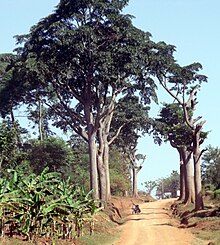
Teak is a tropical hardwood tree species in the family Lamiaceae. It is a large, deciduous tree that occurs in mixed hardwood forests. Tectona grandis has small, fragrant white flowers arranged in dense clusters (panicles) at the end of the branches. These flowers contain both types of reproductive organs. The large, papery leaves of teak trees are often hairy on the lower surface. Teak wood has a leather-like smell when it is freshly milled and is particularly valued for its durability and water resistance. The wood is used for boat building, exterior construction, veneer, furniture, carving, turnings, and various small projects.

A frugivore is an animal that thrives mostly on raw fruits or succulent fruit-like produce of plants such as roots, shoots, nuts and seeds. Approximately 20% of mammalian herbivores eat fruit. Frugivores are highly dependent on the abundance and nutritional composition of fruits. Frugivores can benefit or hinder fruit-producing plants by either dispersing or destroying their seeds through digestion. When both the fruit-producing plant and the frugivore benefit by fruit-eating behavior the interaction is a form of mutualism.

Bactris gasipaes is a species of palm native to the tropical forests of Central and South America. It is well spread in these regions, where it is often cultivated by smallholders in agroforestry systems or more rarely, in monoculture. Common names include peach palm in English, among others used in South American countries. It is a long-lived perennial plant that is productive for 50 to 75 years on average. Its population has an important genetic diversity, leading to numerous fruits, colors, and qualities. The fruits are edible and nutritious but need to be cooked for 30 minutes to five hours. They also benefit many animals in the wild. Peach-palms are also cultivated for the heart of palm, and the trunk can make valuable timber.

Irvingia gabonensis is a species of African trees in the genus Irvingia, sometimes known by the common names wild mango, African mango, or bush mango. They bear edible mango-like fruits, and are especially valued for their fat- and protein-rich nuts.

Brosimum alicastrum, commonly known as breadnut, Maya nut or ramon, and many others, is a tree species in the family Moraceae of flowering plants, whose other genera include figs and mulberries. The plant is known by a range of names in indigenous Mesoamerican and other languages, including: ojoche, ojite, ojushte, ujushte, ujuxte, capomo, mojo, ox, iximche, masica in Honduras, uje in the state of Michoacan Mexico, mojote in Jalisco, chokogou in Haitian Creole and chataigne in Trinidadian Creole. In the Caribbean coast of Colombia it is called guaímaro or guaymaro.

Intsia bijuga, commonly known as Borneo teak, Johnstone River teak, Kwila, Moluccan ironwood, Pacific teak, scrub mahogany and vesi, is a species of flowering tree in the family Fabaceae, native to the Indo-Pacific. It ranges from Tanzania and Madagascar east through India and Queensland, Australia, Papua New Guinea to the Pacific islands of Fiji and Samoa. It grows to around 50 metres tall with a highly buttressed trunk. It inhabits mangrove forests. Intsia bijuga differ from Intsia palembanica in the number of leaflets that make up their compound leaves.

Agathis macrophylla known as Pacific kauri, is a coniferous tree native to the islands of the southwestern Pacific Ocean in tropical humid lowlands and lower montane regions, notably in Fiji, Vanuatu, and the Santa Cruz Islands. The Pacific kauri is one of the largest and fastest growing species in its genus, and is important in forestry.

Acacia mangium is a species of flowering tree in the pea family, Fabaceae, that is native to northeastern Queensland in Australia, the Western Province of Papua New Guinea, Papua, and the eastern Maluku Islands. Common names include black wattle, hickory wattle, mangium, and forest mangrove. Its uses include environmental management and wood.

Dalbergia sissoo, known commonly as North Indian rosewood or shisham, is a fast-growing, hardy, deciduous rosewood tree native to the Indian subcontinent and southern Iran. D. sissoo is a large, crooked tree with long, leathery leaves and whitish or pink flowers.

Widdringtonia wallichii, Clanwilliam cedar or Clanwilliam cypress, previously Widdringtonia cedarbergensis is a species of Widdringtonia native to South Africa, where it is endemic to the Cederberg Mountains northeast of Cape Town in Western Cape Province. Due to harsh weather conditions, like limited rainfall and frequent wildfires, growth is limited. Ring width almost correlates with rainfall due to such harsh environmental conditions It is threatened by habitat loss and protected in South Africa under the National Forest Act of 1998.

Inga edulis, known as ice-cream bean, ice-cream-bean, joaquiniquil, cuaniquilguama or guaba, is a fruit native to South America. It is in the mimosoid tribe of the legume family Fabaceae. It is widely grown, especially by Indigenous Amazonians, for shade, food, timber, medicine, and production of the alcoholic beverage cachiri. It is popular in Peru, Ecuador, Pernambuco-Brazil, Venezuela, Guyana and Colombia. The taxonomic name Inga is derived from its name with the Tupí people of South America (ingá) while the species name edulis is Latin for "edible". The common name "ice-cream bean" alludes to the sweet flavor and smooth texture of the pulp.

The straw-coloured fruit bat is a large fruit bat that is the most widely distributed of all the African megabats. It is quite common throughout its area ranging from the southwestern Arabian Peninsula, across forest and savanna zones of sub-Saharan Africa. It is listed as Near Threatened on the IUCN Red List due to a decreasing population trend. Straw-coloured fruit bats travel in massive colonies of at least 100,000 bats and sometimes massing up to 1 million. From October to end of December every year, in the largest migration of mammals on the planet, up to 10 million straw-coloured fruit bats congregate in Kasanka National Park, Zambia, roosting in a 2 hectare area of Mushitu forest each day. This migration was only discovered in 1980. Their necks and backs are a yellowish-brown colour, while their undersides are tawny olive or brownish.

Afzelia africana, the African mahogany, afzelia, lenke, lengue, apa, or doussi, is a Myrmecophyte tree species in the family Fabaceae.
Milicia regia is a species of tropical tree in the family Moraceae. It grows in a belt on the west coast of Africa that extends from the Gambia to Ghana. It is threatened by habitat loss and logging.

Antiaris toxicaria is a tree in the mulberry and fig family, Moraceae. It is the only species currently recognized in the genus Antiaris. The genus Antiaris was at one time considered to consist of several species, but is now regarded as just one variable species which can be further divided into five subspecies. One significant difference within the species is that the size of the fruit decreases as one travels from Africa to Polynesia. Antiaris has a remarkably wide distribution in tropical regions, occurring in Australia, tropical Asia, tropical Africa, Indonesia, the Philippines, Tonga, and various other tropical islands. Its seeds are spread by various birds and bats, and it is not clear how many of the populations are essentially invasive. The species is of interest as a source of wood, bark cloth, and pharmacological or toxic substances.

Iroko is a large hardwood tree from the west coast of tropical Africa that can live up to 500 years. This is the common name for the genus Milicia, in which there are two recognized species, which are closely related: Milicia excelsa and Milicia regia.

Pentaclethra macroloba is a large and common leguminous tree in the genus Pentaclethra native to the wet tropical areas of the northern Neotropics, which can form monocultural stands in some seasonally flooded habitats. It has giant, bipinnate leaves shaped like feathers. It uses seed dispersal by water to establish itself in new areas, having floating seeds that are left behind after the waters recede after floods or tides. It has hard timber which is not very resistant to rot in the tropics, but it can be treated, has a pretty pink-red colour when dry, and has a number of uses. Oil used in cosmetics is extracted from the large seeds. In the northern Amazon region the bark is used in herbal medicine as an antivenom, and in the Guianas the bark has been used as a fish poison. Despite their toxicity, the seeds are eaten by variegated squirrels, parrots and macaws, and serve as the nurseries of the larvae of the moth Carmenta surinamensis.

Parinari excelsa, the Guinea plum, is a species of large, evergreen tree in the family Chrysobalanaceae. It has a very wide distribution in tropical Africa and the Americas. This species grows to 50 m (160 ft) tall while the trunk is up to 1.5 m (5 ft) in diameter.

Cola nitida is a species of plant belonging to the family Malvaceae.
Teak is a species of large, deciduous tree.




















